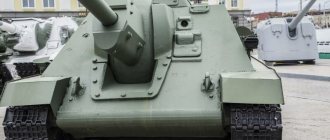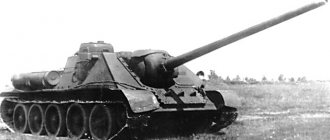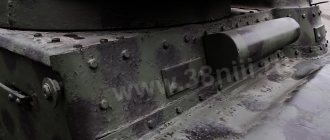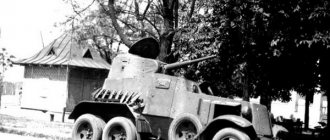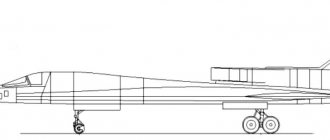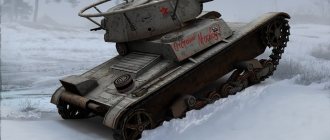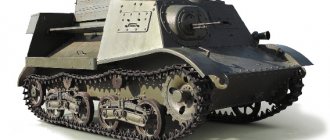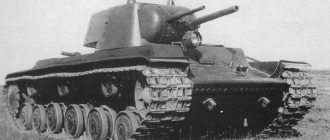Home » Books on the history of tanks » Yuri Pasholok. SU-76M - final version
Books on tank history
boroda 05/17/2019 1477
16
in Favoritesin Favoritesfrom Favorites 9
On July 8, 1943, the light self-propelled gun SU-76M (SU-15M) was adopted by the Red Army. combat vehicle of the Red Army after the T-34/T-34-85 Thanks to its very successful design, the SU-76M did not undergo serious metamorphoses. But towards the end of the Great Patriotic War, taking into account feedback from the fronts, the vehicle underwent a slight modernization, aimed primarily at improving the protection of the fighting compartment. This machine did not receive a new index. It is often called the “post-war SU-76M,” which is incorrect: these self-propelled guns went into production in April 1945, and after the end of World War II they were produced for only two months. During the Soviet-Japanese War, these “post-war” vehicles managed to fight.
Self-propelled gun SU-76. TTX. Dimensions. Reservation. Weight. Story
In the fall of 1942, on the basis of the T-70 tank, a light self-propelled artillery mount was developed under the factory brand name SU-12. On December 9 of the same year, a government test of the car took place. The self-propelled gun received the army name SU-76 and was adopted by the Red Army. In January 1943, serial production of self-propelled guns began. The machine was designed to support
Surviving copies
Currently, three examples of the SU-76i have been preserved.
- Ukraine Ukraine - on a pedestal in the city of Sarny (Rivne region, Ukraine).
- Russia Russia - in the open exhibition of the Museum on Poklonnaya Hill (branch of TsMVS, Moscow). This example is completely authentic except for the gun mantlet and the restored stern plate.
- Russia Russia - in the open exhibition of the Museum of Battle Glory of the Urals (Verkhnyaya Pyshma), the chassis from the PzKpfw III, developed in the design bureau of the Ural Transport Engineering Plant.[1]
Self-propelled gun SU-76 - video
In front of the installation was the driver's seat. On the right side there was a power plant and transmission units. At the rear of the vehicle there was a conning tower with a 76-mm ZIS-Z cannon. The conning tower was protected by a 7 mm thick roof. The frontal part of the hull and the wheelhouse were covered with armor, the thickness of which was 25-35 mm. A total of 360 installations were made.
Almost immediately it became obvious that the SU-76 self-propelled gun had serious defects. These included the following: two carburetor engines through two gearboxes worked in parallel on one common shaft. That is why gear teeth were often cut off during gear changes. In addition, during firing there was a lot of gas in the fighting compartment. This seriously hampered the crew. The State Defense Committee decided to eliminate all shortcomings as soon as possible. In 1943, after the vehicle was modernized, mass production of the improved SU-76M self-propelled guns began.
Soviet light self-propelled gun SU-76M in urban combat. Judging by the angle of elevation, it hits the upper floors of houses, breaking, for example, machine gun nests or positions of faustniks. Most likely, the crews of the ZIS gun (which can be seen a little ahead) and even some howitzer (at the entrance to the arch) were unable to do this (apparently the enemy fire was greatly interfering), so they brought up the self-propelled guns.
Now the car had two engines placed in series one behind the other. The crankshafts were connected to each other. The armored roof was removed. This was done because the roof interfered with the aiming of the gun. In addition, the transmission has been simplified, making operation easier. The weight of the self-propelled gun decreased from 11.2 tons to 10.5 tons. From the point of view of the gunners, the new SU-76M self-propelled gun turned out to be successful. In addition, conditions for the crew have become more comfortable. Self-propelled guns had great speed. Thanks to its lightness, the installation maneuvered perfectly on the battlefield. The SU-76 self-propelled guns were very effective in destroying enemy machine gun emplacements, light tanks, and mortar batteries.
The SU-76M self-propelled guns also proved themselves when repelling infantry attacks, in the offensive, in the destruction of bunkers and bunkers, and in the destruction of tanks. A sub-caliber charge of the ZIS-Z universal divisional gun at a distance of 500 m could penetrate the armor of an enemy tank, the thickness of which was 91 mm. Medium German tanks such as the Panther and Tiger had just this thickness of armor.
Self-propelled artillery units SU-76M of the guard, Lieutenant Colonel Vasily Stepanovich Shonichev (born 1910, commander of the 1513 glanders), the first to enter Austrian soil, are passing through the streets of one of the settlements in Austria.
The SU-76M ammunition load consisted of 60 high-explosive fragmentation and armor-piercing shells. It also included a portable DT machine gun for self-defense. The self-propelled gun's good armor protected the crew from fire, small-caliber artillery and shrapnel. All SU-76M were equipped with radio stations. On the highway the unit developed a speed of 41-45 km/h, on a dirt road - up to 25 km/h. The self-propelled gun's cruising range was 320 and 190 km, respectively. The installation could overcome a trench up to 2 m wide and had a lift of up to 30 *. Also, the SU-76M could ford a depth of up to 0.9 m. The undoubted advantages of the installation included its small size and low specific pressure on the ground. It was 0.545 kgf/cm2. The SAU 76M could move through wooded and swampy areas. This made it possible for the installation to accompany infantry in those places where medium tanks could not move.
The installation had a very efficient cooling system, and also had a reliable engine preheater. Thanks to this, the SU-76M could take part in battles at different times of the year. The installation worked on 6-cylinder automobile engines, which were mastered a little earlier before the start of the war. The engines were very reliable. They could work in tank mode for a long time.
In the summer of 1943, the Gorky Automobile Plant was the main enterprise producing the SU-76M. It was this automobile plant that had great production capabilities, as well as qualified engineering personnel. Deputy Chief Designer for Tank Building N.A. Astrov led the work on the technology of mass production of self-propelled artillery units.
At the end of 1943, the SU-76M also began to be produced at a plant near Moscow, where a design bureau was opened. Armored hulls were produced at specialized enterprises, which were then supplied to the plant. In 1943, 928 units were produced; in 1944, 3.7 times more machines were produced. At the Gorky plant, self-propelled units were constantly being modernized. The improvement concerned armor and weapons. In the summer of 1943, the SU-74A and SU-74D were created with the F-34 tank gun and single engines - ZIS-16F and an imported diesel unit. At the end of 1943, a self-propelled artillery mount was released, designed to destroy enemy SU-74B tanks with a powerful 57-mm anti-tank gun and boosted to 122 hp. With. ZIS engine.
At the end of the Great Patriotic War, light self-propelled artillery units fought battles with heavy enemy tanks. Thousands of SU-76M units entered German territory and took part in street battles, where the maneuverability and mobility of self-propelled guns were especially useful.
In total, about 14,300 SU-76 self-propelled units were produced. Their release continued until the end of the war. The soldiers called the SU-76 self-propelled gun "Columbine". Almost 25 years after the victory of the Soviet troops, Marshal of the Soviet Union K.K. Rokossovsky recalled: “...The soldiers especially liked the SU-76 self-propelled artillery mounts. These light, mobile vehicles kept up everywhere in order to support and rescue the infantry with their fire and tracks, and the infantrymen, in turn, were ready to shield them with their chests from the fire of enemy armor-piercing fighters and faustians ... "
The crew of the SU-76 self-propelled gun A.R. Lalak fires in a populated area in the province of Brandenburg. Germany, 1st Belorussian Front.
Options
SU-76 with parallel installation of engines and an armored roof of the fighting compartment;
SU-76M with parallel installation of engines with increased engine life and without an armored roof for the fighting compartment;
SU-76 with sequential installation of engines operating on a common shaft, with a total power of 140 hp. With.;
SU-76 with a propulsion system operating on a common shaft with a total power of 170 hp. With.
Soviet self-propelled gun SU-76 on one of the destroyed streets of Berlin
Performance characteristics of the SU-76 self-propelled gun
— Layout diagram: combined engine-transmission and controls at the front, combat at the rear — Years of development: 1942 — Years of production: 1942—1945 — Years of operation: 1942—1953 — Number of produced, pcs.: 14,280
— Crew: 4 people
Weight of self-propelled gun SU-76
— Combat weight, t: 11.2
Overall dimensions of self-propelled gun SU-76
— Body length, mm: 5000 — Width, mm: 2740 — Height, mm: 2200 — Ground clearance, mm: 300
Reservation of self-propelled gun SU-76
— Armor type: rolled steel — Hull forehead (top), mm/deg.: 25 / 60° — Hull forehead (bottom), mm/deg.: 35 / 30° — Hull side, mm/deg.: 15 / 0 ° — Hull feed (top), mm/deg.: 10 / 20° — Hull feed (middle), mm/deg.: 15 / 0° — Hull feed (bottom), mm/deg.: 15 / 30° — Bottom, mm: 7 / 81—90° — Hull roof, mm: 7 — Cabin front, mm/deg.: 35/25° — Cabin side, mm/deg.: 10/25° — Cabin stern, mm/deg. .: 10 / 20° — Cabin roof, mm/deg.: 7
Armament of self-propelled gun SU-76
— Caliber and brand of gun: 76.2 mm ZIS-3 — Gun type: rifled — Barrel length, calibers: 41.6 — Gun ammunition: 60 — VN angles, degrees: −3…+25 — GN angles, degrees .: ±15
Engine self-propelled gun SU-76
— Engine type: twin in-line — 6-cylinder carburetor liquid-cooled — Engine power, l. pp.: 2 × 70
Speed of self-propelled gun SU-76
— Highway speed, km/h: 44
— Cruising range on the highway, km: 250 — Specific power, l. s./t: 12.5 — Suspension type: individual, torsion bar
— Overcome ascent, degrees: 30 — Overcome wall, m: 0.6 — Overcome ditch, m: 2.0 — Overcome ford, m: 0.9
More detailed information about the technique:
The SU-76M battle tank is ideal for conducting ambush combat. The 57 mm ZiS-2 gun has excellent penetration and accuracy, which allows it to hit enemies at medium and long distances. However, the gun has low one-time damage, but this is compensated by its normal rate of fire. The vehicle's armor is very weak, so you should stay behind your allies and play the main role. The low viewing range does not allow the PT to be used as an ambush fighter, but with the use of additional equipment this is possible. Excellent camouflage allows you to remain unnoticed even at close distances. Excellent running performance allows you to quickly move around the map and occupy advantageous key positions.
Bottom line: The SU-76M tank can teach any player how to use this class. Since this class of equipment must inflict a large amount of damage per battle, defend the base and support allies.
Photo of self-propelled gun SU-76
Soviet self-propelled gun SU-76M is crossing the river next to a destroyed bridge
A column of Soviet self-propelled guns SU-76M enters a village in the northern part of the province of Pommern (Pommern)
Soviet self-propelled gun SU-76M drives past a broken 88-mm German anti-aircraft gun (8.8 cm FlaK 18) in Vilnius. And in the foreground there is a fragment of a T-34 track lying around. Anti-aircraft gun with extended jacks. Apparently it was left at the crossroads as an anti-tank weapon.
A wounded Soviet soldier is transferred from a SU-76M self-propelled gun to a stretcher near Berlin. I came across mentions that by the end of the war the SU-76m was often used as an infantry fighting vehicle to transport the wounded from the battlefield, this photo sheds light on how this could have happened.
Soviet light self-propelled artillery unit SU-76M, knocked out and burning near the village of Osveya, Verkhnedvinsky district, Vitebsk region. Judging by the damage, a shell fired from the left hit the lower left part of the self-propelled gun hull, tearing off the second road wheel. As a result, at the point of impact, the tires (parts of the tires facing towards the torn out roller) of the first and third road wheels caught fire and were partially burned. The bandage of the torn off skating rink has been preserved. Apparently, the fuel tanks located in the area of the 1st-3rd road wheels on the left side of the vehicle also caught fire. Traces of soot on the first and second support rollers, on the caterpillar and fender indicate intense combustion in the area where the projectile hit.
Self-propelled artillery units SU-76M of the Soviet 1513th self-propelled artillery regiment cross the Hungarian-Austrian border. Ahead is a self-propelled gun with tail number 126.
Officers of the 9th SS Panzergrenadier Regiment "Germany" of the 5th SS Panzer Division "Wiking" inspect a Soviet SU-76 self-propelled gun, destroyed in battles east of Warsaw in the summer of 1944. On the left is SS-Untersturmführer Gerhard Mann, commander of the 11th company of the 9th SS Panzer-Grenadier Regiment "Germany", in the center - SS-Hauptsturmführer Friedrich Hannes, commander of the 12th company of the 9th SS Panzer-Grenadier Regiment "Germany". In my opinion, they do not inspect, but undermine the barrel of the gun. In 1944, the situation changed quickly and not in favor of the Germans. In this simple way you can “finish off” the damaged one. Moreover, the officer standing in the center seems to be showing his colleagues how it’s done. This was actually practiced at the front (according to memoirs), and the use of the M24, as the most convenient for such purposes, sometimes led to the fact that when detonated, the grenade handle flew back “with a whistle.”
The crew of the Su-76M self-propelled gun under the command of ml. Lieutenant I.I. Ivanova is fighting in the province of Brandenburg. The crew did not skimp, they tied as many as 3 logs to the side for self-pulling. And the German trophy bowler hat is very similar to it, which is attached to the stern.
A column of Soviet SU-76 self-propelled guns drives past a buried German Pz.Kpfw.IV tank, which was used as a bunker on a Berlin street. 10 PzKfw 5s and 12 PzKfw 4s were placed at the disposal of the defenders of Berlin in a faulty condition, all of which were installed as fixed firing points at major intersections.
Soviet self-propelled guns SU-76 with troops are heading to the last German positions in the Vistula Lagoon. District of the city of Heiligenbeil (currently the city of Mamonovo in the Kaliningrad region).
The crew of the Soviet self-propelled gun SU-76M is ready to fire at the enemy. The “soft” covering of the door and part of the rear wall of the fighting compartment is visible; it was made standardly, in factory conditions; the upholstery acts as a shock absorber for ejected shell casings. Even the mark from the impact of the cartridge case is visible. The crew did not refuse to use captured MP. The gun commander is on the left, looking around through the panorama periscope. Of the entire crew, he is the only one who is included in the TPU or works with the radio. Phones are inserted into his headset. The charger has a winter headset. He does not use mittens when working with shots.
Soviet self-propelled guns SU-76M on one of the streets of Berlin
A column of Soviet armored vehicles on the street of a German city. The photo shows the T-34-85 tanks and the SU-76M self-propelled guns. This is what air supremacy means - the identification marks on the SU-76, probably because of their external similarity with German self-propelled guns, self-propelled guns had to fight under crosses.
Self-propelled gun SU-76M with armored soldiers from the 10th Tank Corps of the 5th Guards Tank Army of the 2nd Belorussian Front and the bodies of German soldiers on Mühlhausen Street (now the Polish city of Mlynar). The city of Mühlhausen was liberated from Nazi troops on January 24, 1945 during the Mlawa-Elbing operation.
Similar
SAU 2S7 Pion (2S7M Malka) performance characteristics. Caliber. Dimensions. Firing range
MLRS BM-21 Grad. Damage area. Rockets. Caliber. Story
120-mm mortar 2B11 complex 2S12 Sani TTX. Firing range. Weight
Mortar 2B9M Vasilek 82 mm Rate of fire. Firing range. Weight
Self-propelled gun 2S3 Akatsiya 152 mm. Firing range. Dimensions. Weight. Engine
SAU 2S1 Gvozdika 122 mm Firing range. Dimensions. Device. Weight
Gun 2A36 Giatsint-B 152 mm. Firing range. Dimensions. Device
MLRS 9K58 Smerch Damage area. Rockets. Caliber. Story
MT-12 Rapier gun. Firing range. Story. Dimensions
Howitzer D-30 122-mm performance characteristics. Firing range. Dimensions. Weight
2S4 Tulip self-propelled mortar 240 mm performance characteristics. Dimensions. Firing range. Weight
Self-propelled gun 2S35 Koalitsiya-SV 152-mm performance characteristics. Firing range. Dimensions. Weight
Howitzer Msta-B (2A65) 152 mm. Firing range. Dimensions. Weight. Ammunition
Self-propelled gun 2S9 Nona-S 120 mm performance characteristics. Firing range. Dimensions. Weight. Armament
AT-T heavy artillery tractor. TTX. Dimensions. Engine. Story
SAU 2S19 Msta-S 152 mm Dimensions. Speed. Engine. Story
MLRS 9K57 Hurricane Damage area. Rockets. Caliber. Story
TOS-1 Buratino (TOS-1A Solntsepek) performance characteristics. Damage area
Divisional gun ZIS-3 76 mm. TTX. Firing range. Dimensions. Weight
Howitzer gun D-20 152 mm performance characteristics. Firing range. Dimensions. Weight
Howitzer M-30 model 1938 122-mm performance characteristics. Firing range. Dimensions. Weight
Self-propelled gun 2S5 Giatsint-S 152 mm performance characteristics. Firing range. Armament. Dimensions. Weight
Self-propelled gun Ferdinand (Elephant) performance characteristics. Reservation. Weight. Dimensions
Self-propelled gun SU-100. TTX. Armament. Dimensions. Shells. Weight. Speed
Self-propelled gun Sturmtiger caliber 380 mm. TTX. Armament. Shells. Reservation. Dimensions
203-mm howitzer B-4 model 1931 performance characteristics. Weight. Ammunition. Dimensions
Self-propelled gun SU-152 St. John's wort 152 mm performance characteristics. Shells. Firing range. Dimensions. Weight
Gun M-46 130-mm performance characteristics. Firing range. Dimensions. Weight
Demining installation UR-77 Meteorite TTX. Armament. Dimensions
MLRS 9K51M Tornado-G. Rockets. TTX. Firing range. Dimensions
SAU 2S31 Vienna 120 mm. Firing range. Story. Dimensions. Weight
German self-propelled gun StuG III. Modifications. Dimensions. Armament. Weight
Guided projectile Krasnopol. TTX. Firing range. Dimensions. Price
Mortar Karl 600 mm and 540 mm performance characteristics. Firing range. Weight. Dimensions
Big Bertha 420 mm gun. TTX. Weight. Dimensions. Ammunition
Self-propelled gun SU-76. TTX. Dimensions. Reservation. Weight. Story
SAU 2S23 Nona-SVK 120-mm performance characteristics. Armament. Range and accuracy of fire. Dimensions
SAU 2A3 Condenser-2P caliber 406 mm Firing range. Armament. Dimensions. Weight
Mortar M-160 caliber 160-mm performance characteristics. Firing range. Ammunition. Dimensions
Airborne self-propelled gun ASU-57. Armament. TTX. Dimensions. Weight. Booking
Artillery complex A-222 Bereg 130 mm. TTX. Firing range. Ammunition
Howitzer BR-18 caliber 305 mm TTX. Firing range. Weight
152 mm howitzer D-1. Firing range. Dimensions. Weight. Device
Mortar M-240 caliber 240 mm. Firing range. Dimensions. Weight
Self-propelled gun SU-85. Ammunition. Reservation. Dimensions. Weight. Engine
Counter-battery radar Zoo-1 (1L219M). Range of control of firing positions. Device
SAU 2S25 Sprut-SD. Caliber. Story. Dimensions. Weight. Engine
Self-propelled gun 2S34 Hosta 120 mm. TTX. Dimensions. Firing range. Armament. Weight
Self-propelled gun ASU-85. Armament. Dimensions. Reservation. Weight
280-mm mortar Br-5 model 1939 Dimensions. Weight. Ammunition
Self-propelled gun 2A45M Sprut-B. TTX. Speed. Engine. Weight
Belarusian MLRS BelGrad. TTX. Firing range. Ammunition. Dimensions
S-23 cannon 180 mm caliber. Ammunition. Weight. Dimensions. Firing range
Self-propelled gun SAU SU-122. Dimensions. Armament. Reservation. Weight
Self-propelled gun Jagdpanther. Weight. Reservation. Dimensions. Armament
Multi-barreled self-propelled gun M50 Ontos. TTX. Armament. Dimensions. Booking
D-74 cannon 122 mm caliber. Firing range. Dimensions. Weight
Artillery tractor T-20 Komsomolets. Armament. Reservation. Dimensions. Weight
Artillery tractor YA-12. Dimensions. Weight. Load capacity. Engine
SAU ISU-122. Armament. Dimensions. Weight. Booking
RPU-14 (8U38) - rocket launcher
2K32 Deva - 82-mm self-propelled mortar system
MLRS BM-24 (T) 240 mm. Firing range. Dimensions. Weight. Engine
Artillery tractor Comintern. Load capacity. Dimensions. Weight. Engine
Self-propelled gun SU-122-54. Reservation. Dimensions. Weight. Firing range
MLRS BM-14-16. Armament. Dimensions. Weight. Firing range
Self-propelled gun Nashorn (Rhinoceros). Armament. Dimensions. Weight. Booking
BR-2 gun caliber 152 mm. Firing range. Dimensions. Weight
Self-propelled howitzer self-propelled gun PzH 2000. Firing range. Dimensions. Weight
BR-17 cannon 210 mm caliber. Weight. Firing range. Rate of fire
Self-propelled gun Vespe 105 mm. Armament. Dimensions. Reservation. Weight
Wheeled self-propelled gun GAZ-68 (KSP-76). Armament. Dimensions. Weight. Engine
Self-propelled gun Brummbar 150 mm. Armament. Dimensions. Weight. Booking
Heavy self-propelled gun SU-14. Reservation. Dimensions. Weight. Engine
Self-propelled gun SU-5. Armament. Reservation. Dimensions. Weight
Self-propelled gun AT-1. Reservation. Dimensions. Weight. Engine
Self-propelled gun SU-12. Armament. Reservation. Dimensions. Weight
Crew:
- Crew commander;
- Gunner;
- Driver mechanic;
- Loader (Radio Operator).
Learning additional skills for the crew:
Standard crew
:
| 1 | 2 | 3 | 4 |
For the first slot, we teach all crew members the “ Camouflage” , and for the commander the “ Sixth Sense” skill - the “Camouflage” skill will reduce the overall visibility of the tank, and the “Sixth Sense” will allow you to determine whether his tank is detected by the enemy. Also, all crew members need to learn an additional skill “ Combat Brotherhood” , which improves the level of proficiency in the specialty, must be studied by everyone at once, preferably used in the second or third slot.
- the Eagle Eye skill , which increases the viewing range.
- For the gunner we learn the skill “ Smooth turret rotation” , which reduces the spread when turning the turret; and the Sniper , which increases the chances of causing damage to modules and crew members.
- For the driver mechanic, we learn the “ Smooth Move” , which reduces the dispersion of the gun in motion; and the Off-Road King , which reduces drag on soft to medium ground when driving.
- For the loader, we learn the skill “Non-contact ammo rack ,” which increases the strength of the ammo rack; and the “ Radio Interception” , which increases the viewing range.
